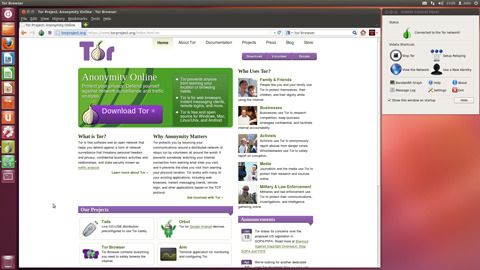
Tor is free software and an open network that helps you defend against a form of network surveillance that threatens personal freedom and privacy, confidential business activities and relationships, and state security known as traffic analysis.
Tor prevents people from learning your location or browsing habits.
Tor is for web browsers, instant messaging clients, and more.
Tor is free and open source for Windows, Mac, Linux/Unix, and Android
THIS IS FREEWARE AND WE HIGHLY RECOMMEND USING IT TO SURF ANONYMOUSLY AND WITHOUT ANY CENSORSHIP!
Why Anonymity Matters
Tor protects you by bouncing your communications around a distributed network of relays run by volunteers all around the world: it prevents somebody watching your Internet connection from learning what sites you visit, and it prevents the sites you visit from learning your physical location. Tor works with many of your existing applications, including web browsers, instant messaging clients, remote login, and other applications based on the TCP protocol.
This is a Mozilla Firefox based software!
Tor is a network of virtual tunnels that allows people and groups to improve their privacy and security on the Internet. It also enables software developers to create new communication tools with built-in privacy features. Tor provides the foundation for a range of applications that allow organizations and individuals to share information over public networks without compromising their privacy.
Individuals use Tor to keep websites from tracking them and their family members, or to connect to news sites, instant messaging services, or the like when these are blocked by their local Internet providers. Tor’s hidden services let users publish web sites and other services without needing to reveal the location of the site. Individuals also use Tor for socially sensitive communication: chat rooms and web forums for rape and abuse survivors, or people with illnesses.
Journalists use Tor to communicate more safely with whistleblowers and dissidents. Non-governmental organizations (NGOs) use Tor to allow their workers to connect to their home website while they’re in a foreign country, without notifying everybody nearby that they’re working with that organization.
Groups such as Indymedia recommend Tor for safeguarding their members’ online privacy and security. Activist groups like the Electronic Frontier Foundation (EFF) recommend Tor as a mechanism for maintaining civil liberties online. Corporations use Tor as a safe way to conduct competitive analysis, and to protect sensitive procurement patterns from eavesdroppers. They also use it to replace traditional VPNs, which reveal the exact amount and timing of communication. Which locations have employees working late? Which locations have employees consulting job-hunting websites? Which research divisions are communicating with the company’s patent lawyers?
A branch of the U.S. Navy uses Tor for open source intelligence gathering, and one of its teams used Tor while deployed in the Middle East recently. Law enforcement uses Tor for visiting or surveilling web sites without leaving government IP addresses in their web logs, and for security during sting operations.
The variety of people who use Tor is actually part of what makes it so secure. Tor hides you among the other users on the network, so the more populous and diverse the user base for Tor is, the more your anonymity will be protected.
Why we need Tor
Using Tor protects you against a common form of Internet surveillance known as “traffic analysis.” Traffic analysis can be used to infer who is talking to whom over a public network. Knowing the source and destination of your Internet traffic allows others to track your behavior and interests. This can impact your checkbook if, for example, an e-commerce site uses price discrimination based on your country or institution of origin. It can even threaten your job and physical safety by revealing who and where you are. For example, if you’re travelling abroad and you connect to your employer’s computers to check or send mail, you can inadvertently reveal your national origin and professional affiliation to anyone observing the network, even if the connection is encrypted.
How does traffic analysis work? Internet data packets have two parts: a data payload and a header used for routing. The data payload is whatever is being sent, whether that’s an email message, a web page, or an audio file. Even if you encrypt the data payload of your communications, traffic analysis still reveals a great deal about what you’re doing and, possibly, what you’re saying. That’s because it focuses on the header, which discloses source, destination, size, timing, and so on.
A basic problem for the privacy minded is that the recipient of your communications can see that you sent it by looking at headers. So can authorized intermediaries like Internet service providers, and sometimes unauthorized intermediaries as well. A very simple form of traffic analysis might involve sitting somewhere between sender and recipient on the network, looking at headers.
But there are also more powerful kinds of traffic analysis. Some attackers spy on multiple parts of the Internet and use sophisticated statistical techniques to track the communications patterns of many different organizations and individual. . Encryption does not help against these attackers, since it only hides the content of Internet traffic, not the headers.
NOTE: IF THE LINKS DO NOT REDIRECT YOU PROPERLY TO THE PAGE, PLEASE COPY THE LINK AND PASTE IT ON YOUR BROWSER
LEARN MORE ABOUT TOR
https://www.torproject.org/about/overview.html.en
THIS IS THE OFFICIAL WEBSITE
https://www.torproject.org/index.html.en
DOWNLOAD THE TOR BROWSER FROM HERE – DO NOT DOWNLOAD FROM ANY OTHER SITE, DOWNLOAD FROM THE MAIN ORIGINAL PAGE ONLY:
https://www.torproject.org/download/download-easy.html.en
Download the Vidalia Bridge Bundle for Windows from here: A Vidalia Bundle which is configured to be a bridge by default. This helps censored users reach the Tor network.
https://www.torproject.org/download/download.html.en
Download Torbuton for Firefox from here:
https://archive.torproject.org/tor-package-archive/torbutton/torbutton-1.5.2.xpi
.

















13 Responses to this entry.